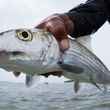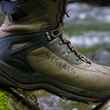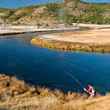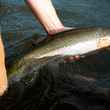A few years ago, while I was wade fishing Montana’s Missouri River on a windy January day, I was struck from behind by a huge, slow-moving ice flow and pushed out into a deep channel maybe a hundred yards from the nearest bank. I went under a couple of times as I tried to swim in my waders and a heavy, sodden insulated jacket, and if not for the help of a fellow angler, it’s unlikely I would have survived.
Looking back, I made a couple of major mistakes that day. Perhaps the biggest was that I wasn’t wearing a personal floatation device. A PFD, or “life jacket,” can help keep your head above water in a survival situation. Having been there myself, I can honestly say that keeping your head above water is incredibly important. After all, it’s far less likely you’re going to drown if you’re breathing air instead of water.
Sadly, most anglers — including yours truly — are hesitant to wear PFDs. A lot of us, and especially those of us with a little gray in our beards, have memories of really crappy life jackets from our younger days. I’d no more fish in one of those ungainly orange PFDs with the tangle of white straps and D-rings than I’d take a Zebco push-button combo on my next fly fishing trip to the Beaverkill or the Henry’s Fork.
The good news, though, is that there are some truly excellent PFDs available for anglers right now and they seem to fall into two major categories — fishing vest/life jacket hybrids and inflatables. Part two of this story looks at inflatables.
Part Two — Inflatables
There’s something inherently appealing about a streamlined PFD that takes up far less room than traditional models and that inflates either manually or automatically when you find yourself in the water. The concept offers a whole new level of comfort for anglers who are used to more traditional life jackets.
You’ll want to keep in mind, though, that inflatable PFDs are not recommended for weak swimmers, or for people who can’t swim at all, or for children, or for use in white water. There’s also the (very slim) chance that these particular PFDs could inflate prematurely, or not inflate when you need them. Nor is there built-in storage for your flies or other gear.
If you do decide to give inflatable PFDs a shot, make sure that your CO2 cylinder is full and correctly installed. Otherwise the PFD won’t work.
Long story short, there are a few trade-offs involved with inflatables and you should look long and hard at both the risks and the benefits before you make your final choice on which particular life jacket is best for you. Ultimately, you are responsible for your own safety and you’ll want to make an intelligent, informed decision.

Onyx A/M/24 Automatic/Manual Inflatable Life Jacket
The A/M/24 is a thin, U-shaped PFD that rests on your shoulders and straps around you chest. There’s one quick release buckle that secures it in place, and one adjustable strap that you tighten or loosen around your chest to achieve the optimum fit. Other than one large D ring near the bottom of the right hand side, there’s no way to attach forceps or nippers. You activate the manual inflation by jerking on the handle that dangles from the bottom of the right hand tube.
The Onyx A/M/24 is a dream to wear. Compared to traditional PFDs, or to hybrid fishing vest/life jackets, it’s light, it’s thin and it’s comfortable. And that’s a good thing, because as I was doing the research for this story I heard over and over that the best life jacket is the one you’ll use on the water. If you go for an unintended swim and your life jacket is stashed in your boat’s dry storage or back in your truck, it might as well be on the moon.
Keep in mind that you’ll need to follow the instructions to the letter and install the CO2 cartridge correctly. That goes for both the initial use, and for any subsequent use. (You discard the CO2 cartridge after each inflation, so make sure you have a spare or two handy.) You’ll also need to perform regular inspections to make sure that the PFD is in good working condition.
My suggestion is that anyone who purchases the Onyx A/M/24 should use it on dry land first to familiarize themselves with its operation. There’s a manual inflation/deflation tube tucked into the PFD and I found that, after I initiated the manual release I needed to let some of the air out of the A/M/24 so that the fully inflated bright yellow bladder didn’t cut off the circulation to my head. (I’m a reasonably large person and the fit was extremely snug around my neck and head.)
There’s one last point I should mention. You’ll have to wear this particular Onyx over top of everything else. It should work just fine over a jacket, but I don’t recommend using it over, or in conjunction with, a fishing vest or a sling pack.
Onyx M/16 Belt Pack Manual Inflatable Life Jacket
If the Onyx A/M/24 is a minimalist dream — and it is — then the Onyx M/16 takes minimalism to a whole different level. Rather than draping around your shoulders and hanging down on either side of your chest, the M/16, which is the size of a tiny fanny pack, straps around your waist. That’s it. There’s one waist strap to adjust, and one quick release buckle, and other than a single beefy D-Ring, that’s about it.
The good news is that this little belt pack is so unobtrusive, and so easy to wear and use that it takes pretty much all the hassle out of a PFD. The downside - if you want to call it that - is that rather than inflating into a traditional life jacket that surrounds your chest & neck and keeps your head floating out of the water, the Onyx M/16 converts into a sturdy bright yellow air pillow with a single black strap on the top. If that sounds like you’d be in the water with a bright yellow pool float strapped to your waist … well, you’re not far wrong. This particular PFD will give you something to grab on to in the event you go for an unintended swim, but it’s definitely not going to keep your head out of the water if you start out disabled or unconscious.
I also found that the 16 gram CO2 canister that comes with the belt pack didn’t completely inflate the PFD. I’m not sure that’s a major problem — I was able to blow into the attached inflation/deflation tube a couple of times and the air bladder inflated all the way — but if I was in survival situation in rough water or a fast current, I have to wonder whether an under-inflated bladder could be more of an issue.
So what’s the bottom line? Well, the M/16 is incredibly easy to wear, and to use - there’s no automatic inflation; you activate the manual inflation with a simple pull on the handle — and it could be a real asset for anglers who unexpectedly find themselves in the water. At the same time, though, I’d definitely recommend that you err on the side of caution. Unless you’re a strong swimmer in good physical condition, the M/16 Belt Pack might not provide everything that you’re looking for in a PFD.
West Marine Ultra-Slim Manual Inflatable Life Jacket Belt Pack
This West Marine Belt Pack (pictured above) is very similar in size and function to the Onyx I looked at earlier. It’s incredibly comfortable and it’s designed for active users like kayakers, paddleboarders and, fortuitously, anglers. You wear the Belt Pack, which is thin and light, around your waist - be sure to keep the pull cord in front, where you can reach it - and rather than deploying into a traditional life jacket when you pull the release, it inflates into a bright yellow air bladder with a black nylon strap that you can hold on to, or potentially slip over your head. (While the photo that comes with the belt pack shows a person with his head and neck supported by the strap, you might want to try that maneuver on dry land before you employ it in the water. I suspect it will be easier for some people than others.)
The West Marine Belt Pack does not inflate automatically in the water so you’ll have to pull the cord to inflate the bladder. One minor downside is that the included CO2 canister does not completely inflate the bladder. If you want to inflate the PFD to its maximum capacity, you’ll need to blow a few breaths into the inflation/deflation tube.
On the bright side, you’d be hard pressed to find a U.S. Coast Guard-approved PFD that’s smaller, lighter or more comfortable - and this West Marine model should work equally well for boaters and wading anglers. All in all, it’s definitely worth your consideration if you keep yourself in good shape and you’re also a strong swimmer.
Conclusions
So which type of PFD makes the most sense? That’s going to depend on who you are and what you’re looking for. If you’re active, physically fit, and comfortable with your swimming, and if you don’t mind doing a little routine maintenance from time to time, then an inflatable could be a solid choice. You won’t find a less obtrusive option, and they’re super easy to wear and use.
If you’re older, though, or if you aren’t as physically fit, or if you want a PFD that gives you a place to stash your flies, tippet, leaders, etc., then a hybrid fishing vest/ life jacket might make the most sense. Whatever you choice you make, though, keep in mind one simple fact. A life jacket will only help save your life if you’re wearing it when you need it.
This is Part Two of Life Savers. In Part One, we take a look at hybrid PFDs.































Comments